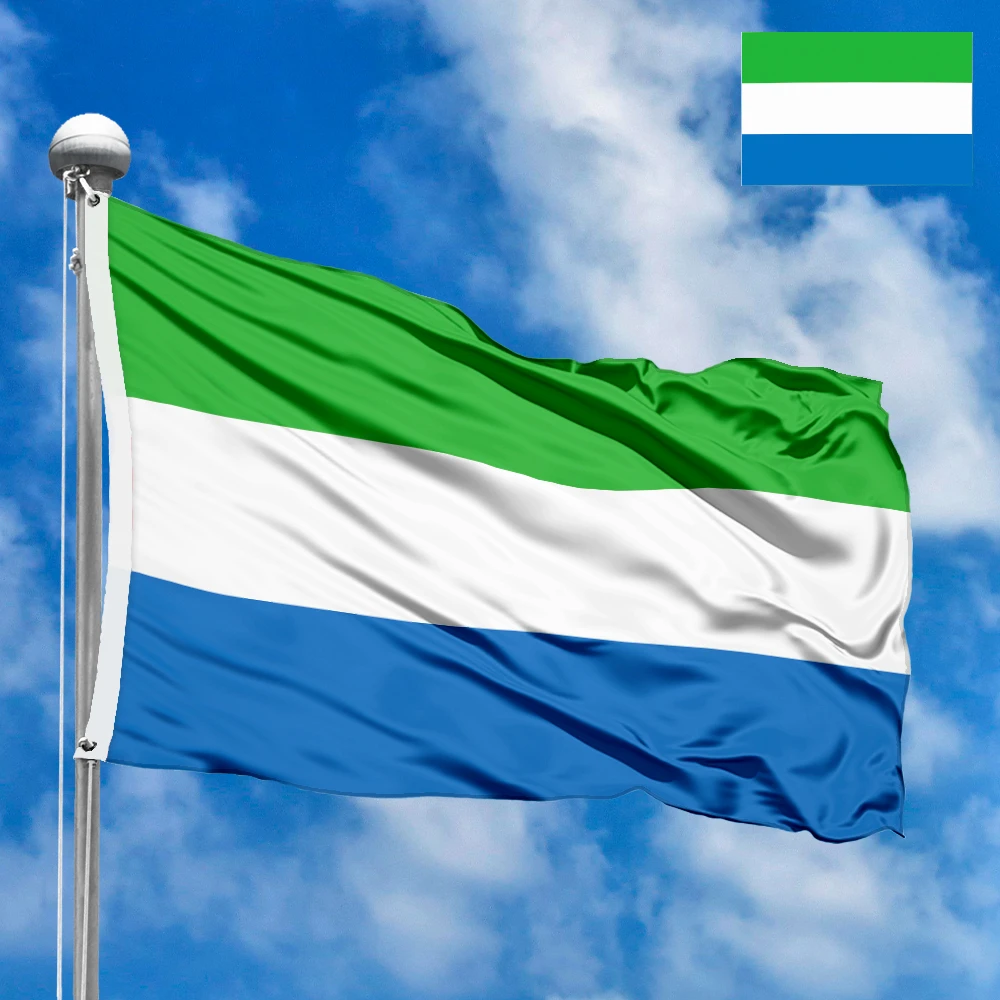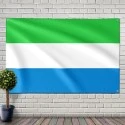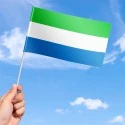The national flag of Sierra Leone is a striking tricolor, a bold and vibrant representation of the West African nation's geography, its aspirations for peace, and its rich natural resources. Adopted on April 27, 1961, the day Sierra Leone gained independence from British colonial rule, the flag’s design is a powerful visual statement of the country's identity and future. Its simplicity and clear symbolism resonate deeply with the people of Sierra Leone, embodying their collective spirit and hopes.
Design and Symbolism: A Tribute to Land, Resources, and Peace
The flag of Sierra Leone consists of three equal horizontal stripes of green, white, and blue. Each color is carefully chosen to convey specific meanings pertinent to the nation's character and ambitions:
-
Green Stripe (Top): The uppermost stripe is a lush, verdant green. This color profoundly symbolizes the nation's rich agricultural and natural resources. Sierra Leone is blessed with fertile lands, abundant forests, and significant mineral wealth, including diamonds, rutile, and bauxite. The green also represents the country's majestic mountains, which dominate its landscape. More broadly, it signifies hope, growth, and the agricultural prosperity that is vital for the nation's development and the well-being of its people. It is a constant reminder of the country's natural bounty and its potential for a flourishing future.
-
White Stripe (Middle): The central stripe is pure white. White is universally recognized as a symbol of peace, purity, and justice. For Sierra Leone, this stripe reflects the nation's fervent desire for lasting peace and unity, particularly after periods of internal conflict. It embodies the commitment of the Sierra Leonean people to resolve differences through dialogue and reconciliation, striving for a harmonious society where justice and dignity prevail for all. It represents the peace that has been achieved and the peace that is continuously sought and maintained within the nation's borders and with its neighbors.
-
Blue Stripe (Bottom): The lowest stripe is a vibrant blue. This color represents the Atlantic Ocean, which borders Sierra Leone to the west, and the natural harbor of Freetown, the capital city. Sierra Leone's historical connection to the sea, particularly its role as a port for the repatriation of freed slaves, is significant. The blue symbolizes the hope that the unique, deep-water harbor of Freetown will contribute to the development of the country and its maritime trade. It also signifies the nation's aspiration for a bright and prosperous future through its coastal resources and its engagement with the wider world through sea routes.
Dimensions and Proportions:
The flag of Sierra Leone adheres to a standard width-to-length ratio of 2:3. The three horizontal stripes are of equal width, ensuring a balanced and harmonious appearance. This consistent proportion allows for accurate reproduction and recognition of the flag globally, reinforcing its distinct visual identity.
History and Evolution: From Colonial Ensign to National Emblem
Before its independence, Sierra Leone was a British colony and protectorate. The area around Freetown was established in the late 18th century as a settlement for freed slaves, gaining the name "Freetown" (founded in 1792). Over the years, the British presence expanded, and Sierra Leone became a Crown Colony in 1808. During this colonial period, various versions of British flags, such as the Blue Ensign with the colonial badge, were used to represent the territory.
As the movement for independence gained momentum in the mid-20th century, the need for a distinctive national symbol became apparent. The design of the new flag was chosen to reflect the aspirations and identity of the soon-to-be independent nation. The green, white, and blue colors were selected for their profound symbolism, representing the country's natural wealth, its desire for peace, and its connection to the ocean.
The flag was officially hoisted for the first time on April 27, 1961, at midnight, marking the moment Sierra Leone became an independent sovereign state. This historic event was met with widespread jubilation and national pride. The flag has remained unchanged since its adoption, serving as a constant emblem of the nation's sovereignty and its enduring values. Its simple yet powerful design has stood the test of time, continuing to inspire generations of Sierra Leoneans.
Regional Context and West African Significance:
Sierra Leone is located on the west coast of Africa, bordered by Guinea to the northeast, Liberia to the southeast, and the Atlantic Ocean to the southwest. Its geographical position gives it strategic importance in the sub-region. The flag’s colors, while distinct, align with common themes found in other West African nations' flags: green often represents agriculture and natural resources, and blue frequently symbolizes the ocean or rivers vital to the region.
The design, however, is unique to Sierra Leone, reflecting its particular history and the aspirations of its people. It stands as a symbol of stability and the pursuit of peace in a region that has, at times, faced its share of challenges. The flag also represents Sierra Leone's commitment to regional cooperation and its active participation in organizations like the Economic Community of West African States (ECOWAS) and the African Union (AU). It reflects a blend of national pride and a wider sense of African identity and solidarity.
Interesting Facts:
-
Independence Day Adoption: The flag was raised precisely at midnight on April 27, 1961, signifying the exact moment of Sierra Leone's independence from the United Kingdom.
-
"Lion Mountains" Origin: The name "Sierra Leone" means "Lion Mountains" (from the Portuguese "Serra Leoa"), believed to have been given by Portuguese explorer Pedro de Sintra in 1462 due to the shape of the mountains and the roaring thunder. The flag, while not directly depicting a lion, embodies the country's natural landscape.
-
Simple yet Profound: The flag's design is deceptively simple, yet each color carries deep, significant meaning for the nation.
-
No Coat of Arms: Unlike some flags that incorporate a national coat of arms, Sierra Leone's flag relies solely on its colored stripes for its symbolism.
-
Symbol of Resilience: Especially after its civil war, the white stripe (peace) has taken on an even more profound meaning for the citizens, symbolizing their resolve to maintain peace and rebuild the nation.
-
Maritime Connection: The blue stripe highlights the country's crucial coastal location and its historic connection to the Atlantic Ocean.
Significance for the Inhabitants: A Banner of Hope, Peace, and Progress
For the people of Sierra Leone, the national flag is a source of immense pride, a powerful unifying symbol, and a constant reminder of their journey as a nation. It encapsulates their shared history, their resilience in overcoming adversity, particularly the brutal civil war, and their collective aspirations for a brighter future.
The green color evokes a sense of belonging to a fertile land, promising agricultural abundance and sustainable development. It reminds them of their natural heritage and the responsibility to protect it. The white stripe holds a particularly deep emotional significance, representing the hard-won peace that is cherished by all. It is a symbol of reconciliation, unity, and the determination to prevent a return to conflict. The blue stripe connects them to the sea, symbolizing their historical ties, their potential for maritime trade, and their openness to the world.
During national holidays, such as Independence Day, and other patriotic events, the flag is proudly displayed across the country – on public buildings, private homes, vehicles, and even worn as attire. It transcends ethnic and religious differences, fostering a strong sense of national identity and solidarity. The flag of Sierra Leone serves as a beacon of hope, inspiring its citizens to work together for justice, peace, and the sustainable development of their beloved "Lion Mountains" nation. It is a cherished emblem that speaks to their past struggles, their present resolve, and their future dreams.
In the demonstration images, full-size flags are shown with proportions of 2:3, and hand-held flags with proportions of 1:2.






 Waving flag
Waving flag
 Sizes:
Sizes:
 Round flag
Round flag
 Sizes:
Sizes:
 Rectangular flag 2:3
Rectangular flag 2:3
 Sizes:
Sizes: